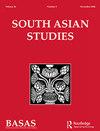IF 0.7
0 ASIAN STUDIES
引用次数: 2
摘要
印度微型绘画、雕塑和纺织品的例子是匿名的,这个论点不能令人信服。它们之所以没有被博物馆收藏,更有可能是因为它们是由非职业女性作为家庭物品制作的,因此不太可能引起当时(主要是男性)博物馆馆长的注意。这本书的核心是以加尔各答古鲁萨迪博物馆(Gurusaday Museum)和费城艺术博物馆(Philadelphia Museum of Art)的两件历史文物为案例研究,围绕这两件文物构建了对19世纪和20世纪初孟加拉殖民地生活方方面面的复杂叙述。这两件坎塔都是精心挑选的:两件(不同寻常的)都绣有铭文,上面写着制造者的名字和制作原因——一件是送给制造者父亲的礼物,另一件是对罗陀和奎师那的赞美。这两个kantas在视觉上非常不同,尽管它们的主题描绘风格不在讨论范围内。其中一本主要是世俗的主题,而另一本则讲述了罗陀和奎师那的故事。这两幅画上描绘的场景是作者巧妙地探讨孟加拉女性识字、妇女在民族主义运动中的地位、寡妇的地位、孟加拉先生及其肖像的演变、家庭暴力、公共交通、侍从和仆人的角色、舞蹈和舞者、印度教旅行游子、卡利加特绘画和巴塔拉版画、孟加拉币、对花花公子的讽刺描绘等主题的起点。婆罗门和意志薄弱的人,以及莲花、游船和合成动物的肖像。这本书主要通过民族志、文学和档案资料,而不是从艺术史的角度来研究坎塔;因此,与其他关于坎达刺绣的书籍相比,它的插图很少。丰富的尾注提供了比较作品的细节,但更多的插图将是受欢迎的。卡利加特绘画的插图,流行的版画和兵马俑寺庙雕刻简洁地说明了他们的观点。有时,语言倾向于学术术语和冗长的句子。考虑到对孟加拉殖民地生活的广泛讨论,我很惊讶地发现,书中没有提到俾路查纱丽(Baluchar sari),这是与坎塔(kantha)同时代的一种纱丽,它的图像也使用了人物(和蒸汽火车),尽管是由城市背景下的专业男性织布工制作的。虽然我发现关于现代干塔的部分太长了,但对这两件特色作品的腹地的探索充满了兴趣。作者对坎塔斯上的图像进行了详细的分析,并对其进行了解释,这不仅使我们更仔细地观察了这些作品本身,而且还邀请我们更广泛地思考19世纪和20世纪初孟加拉妇女的生活是什么样的。前高级策展人,维多利亚和阿尔伯特博物馆rosemarycrill@gmail.com©2021,Rosemary Crill https://doi.org/10.1080/02666030.2021.1893021本文章由计算机程序翻译,如有差异,请以英文原文为准。
Krishna’s lineage. The Harivamsha of Vyāsa’s Mahābhārata
examples of Indian miniature painting, sculpture and textiles are anonymous this argument does not convince. Their absence from museum collections is more likely to be because they were made as domestic objects by non-professional women, and were thus much less likely to come to the attention of the (mostly male) museum curators of the time. The core of the book takes two historic kanthas, one in the Gurusaday Museum in Kolkata and one in the Philadelphia Museum of Art, as case studies around which to build many-stranded narratives of aspects of life in colonial Bengal in the 19 and early 20 century. The two kanthas are well-chosen: both (unusually) have embroidered inscriptions giving the name of the maker and an indication of why they were made – one as a gift to the maker’s father, and the other in praise of Radha and Krishna. The two kanthas are visually very different, although the styles in which their motifs are depicted are not part of the discussion. One of the kanthas bears mostly secular motifs, while the other illustrates stories of Radha and Krishna. The scenes depicted on the two kanthas are starting points from which the author skilfully explores subjects such as female literacy in Bengal, the place of women in the nationalist movement, the status of widows, the evolution of the Bengali babu and his depictions, domestic violence, public transport, the role of attendants and servants, dance and dancers, Hindu travelling gosains, Kalighat paintings and Battala prints, Bengali coinage, satirical depictions of dandies, brahmins and weakwilled men, and iconographies of the lotus, pleasureboat rides and composite animals. The book approaches kantha mainly through ethnographic, literary and archival sources rather than from the viewpoint of art history; as a result, it is sparsely illustrated compared with other books on kantha embroidery. The copious endnotes give details of comparative pieces, but more illustrations of such pieces would have been welcome. Illustrations of Kalighat paintings, popular prints and terracotta temple carvings make their points succinctly. At times the language tends to academic jargon and the sentences to longwindedness. Given the breadth of the discussion of life in colonial Bengal, I was surprised to see no mention of the Baluchar sari, a contemporary of the kantha that also uses human figures (and steam trains) in its iconography, albeit made by professional male weavers in urban settings. While I found the sections on the modern-day kantha over-long, the exploration of the hinterland of the two featured pieces is full of interest. The detailed analysis of the images on the kanthas and the interpretations that the author suggests for them not only make us look more closely at the pieces themselves but also invite us to reflect more broadly on what life was like for a woman in 19 and early 20-century Bengal. Rosemary Crill Former Senior Curator, Victoria and Albert Museum rosemarycrill@gmail.com © 2021, Rosemary Crill https://doi.org/10.1080/02666030.2021.1893021
求助全文
通过发布文献求助,成功后即可免费获取论文全文。
去求助

 求助内容:
求助内容: 应助结果提醒方式:
应助结果提醒方式:


